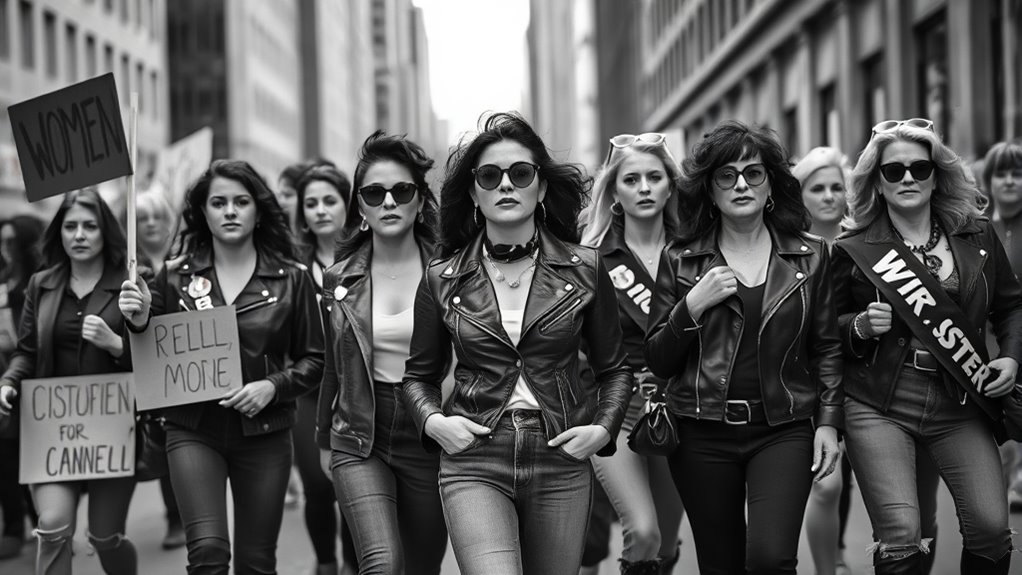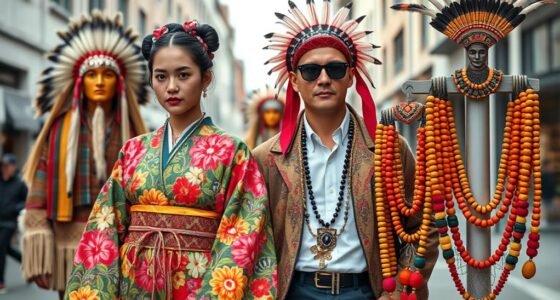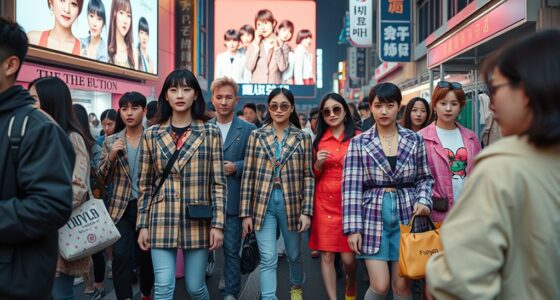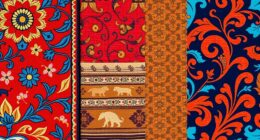Fashion has been a powerful tool for women to challenge societal norms and express their independence. From the flapper era’s bold styles to power suits that symbolize confidence in the workplace, clothing has marked moments of liberation. Counterculture looks and body positivity movements continue to push boundaries. If you explore further, you’ll discover how fashion continues to empower women and shape social change across generations.
Key Takeaways
- Clothing like flapper dresses and short skirts symbolized independence and challenged gender norms during the women’s liberation movements.
- Practical attire such as jeans and T-shirts became statements of rebellion and equality in the 1970s feminist movement.
- Fashion choices in the 1960s counterculture used bright colors and denim as acts of protest and resistance against societal expectations.
- Power suits in the workplace represented women’s increasing authority, challenging traditional gender roles and stereotypes.
- Inclusive and body-positive fashion promotes self-empowerment and challenges narrow beauty standards within feminist movements.
The Flapper Era and the Birth of Modern Women’s Fashion
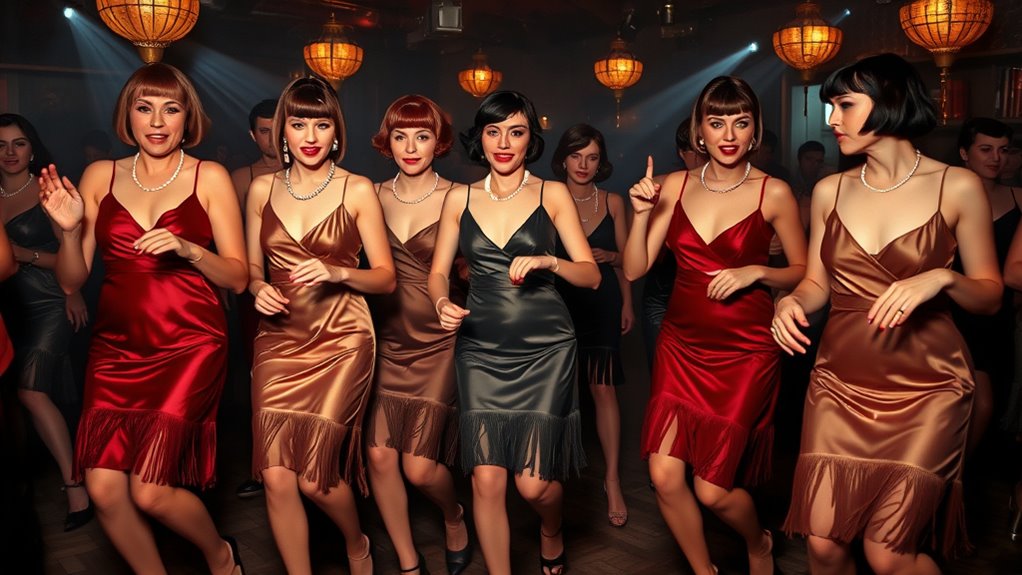
The Flapper Era marked a revolutionary shift in women’s fashion, reflecting the broader social changes of the 1920s. During the Jazz Age, flapper fashion challenged traditional norms, emphasizing freedom and individuality. You might notice that flappers wore shorter skirts, loose dresses, and bold accessories, symbolizing breakaway from Victorian modesty. The era celebrated a carefree attitude, and fashion played a key role in expressing that spirit. You’d see women bobbing their hair, donning cloche hats, and embracing bold makeup—all signs of newfound independence. This bold style helped women assert their autonomy and reject old constraints. The jazz-infused energy of the period made flapper fashion a symbol of modernity, empowerment, and a step toward gender equality. Additionally, the use of vintage clothing and accessories reinforced the connection between fashion and the social liberation movements of the time. Moreover, the era’s fashion choices were influenced by social and cultural shifts, enabling women to challenge traditional expectations and redefine their roles in society.
Power Suits and the Workplace Revolution

Power suits became a symbol of women’s increasing presence in the workplace, signaling a shift in professional attire and gender roles. They project confidence and authority, challenging traditional stereotypes. Today’s power suits often incorporate sustainable fabrics, reflecting a commitment to environmental responsibility. Cultural influences from different regions shape styles, colors, and cuts, blending tradition with modernity. For example, Western sharp blazers and Asian-inspired tailoring merge for a global look. To help visualize, here’s a quick comparison:
| Feature | Cultural Influence |
|---|---|
| Fabric Choices | Sustainable fabrics like organic cotton |
| Style Elements | Sharp lines, minimal detailing |
| Color Palette | Neutral tones with bold accents |
You’re not just dressing for work; you’re making a statement about empowerment and progress. Incorporating quality assurance practices in fashion design and production can further ensure that these garments meet safety and sustainability standards, which is increasingly important in today’s ethical fashion movement.
The 1960s Counterculture and Fashion as Protest
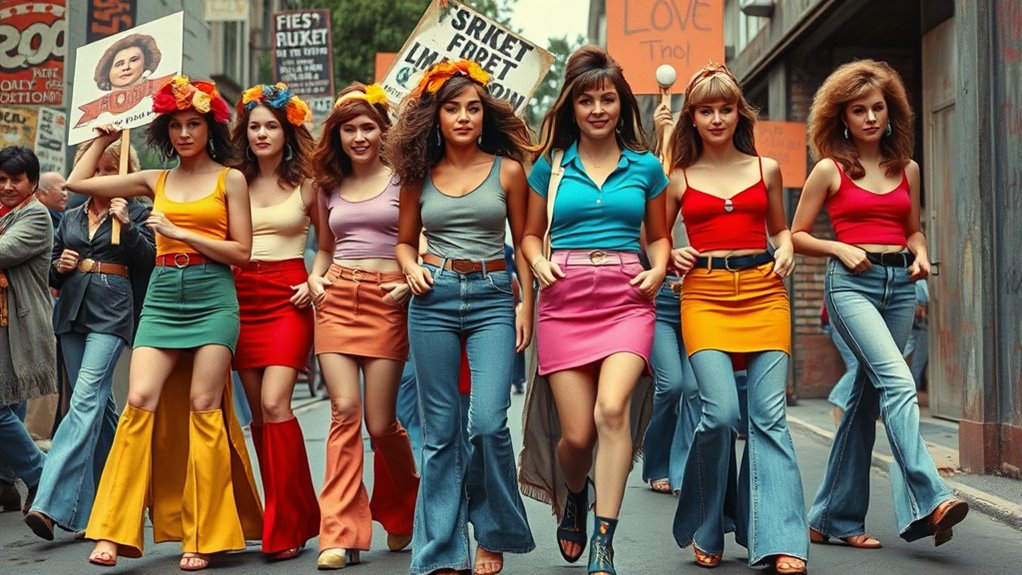
During the 1960s, fashion became a bold act of rebellion, with flamboyant styles shouting opposition to mainstream norms. You see, young people used clothing as a way to express their resistance, often choosing denim to make a political statement. These fashion choices turned clothing into powerful tools for protest and social change. Furthermore, the rise of Free Floating styles allowed for greater individual expression beyond traditional dress codes. This shift also reflected the broader movement towards personal autonomy, emphasizing self-expression and rejecting societal constraints.
Flamboyant Styles and Rebellion
In the 1960s, fashion became a bold statement of rebellion against traditional norms, reflecting the era’s countercultural spirit. You embraced flamboyant styles that challenged gender norms and societal expectations, using clothing as a form of protest. Bright colors, unusual patterns, and unconventional accessories allowed you to express individuality and defy the conservative standards of the previous generation. By adopting these daring looks, you questioned the rigid roles assigned to men and women, turning fashion into a tool for empowerment. Your choices symbolized a desire for freedom, equality, and self-expression, breaking away from the expectations that confined you. This flamboyant rebellion not only reshaped fashion but also fueled the broader movement toward gender equality and social change. The use of color and pattern in clothing became a powerful visual language for expressing dissent and advocating for social justice. Additionally, the incorporation of protective styling benefits through creative fashion choices helped challenge traditional notions of femininity and masculinity, emphasizing personal empowerment.
Denim as Political Statement
As the 1960s unfolded, fashion continued to serve as a powerful tool for expressing dissent, with denim emerging as a symbol of rebellion and political activism. You saw denim become a staple in political fashion, embodying ideals of equality, free expression, and resistance. Wearing jeans wasn’t just about style; it was about making a statement—part of denim activism that challenged societal norms. The simple yet versatile fabric became a canvas for protest and identity. Whether in peace movements or civil rights marches, denim symbolized unity and defiance. Its durability and accessibility made it an ideal clothing choice for those seeking to make their voices heard through fashion. Additionally, the widespread availability and affordability of denim made it an inclusive symbol of resistance, accessible to a broad spectrum of activists and everyday citizens alike.
The Role of Clothing in the Women’s Rights Movement of the 1970s
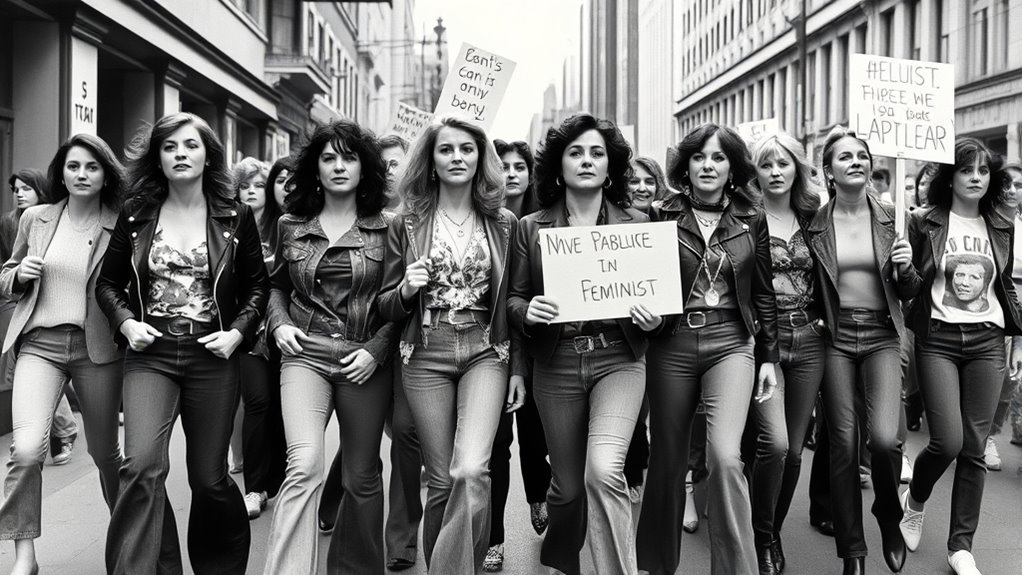
Clothing became a powerful tool for women in the 1970s to challenge societal norms and express their independence. During this era, women used clothing symbolism to confront traditional gender norms, rejecting the restrictive styles of the past. Wearing jeans, T-shirts, and minimal makeup, they embraced casual, practical attire that signified equality and rebellion. These choices communicated a message: women could define their identity beyond conventional expectations. The movement also popularized unisex styles, blurring gender distinctions and emphasizing personal freedom. By adopting clothing that defied stereotypical femininity, women visually asserted their desire for social change. Your clothing choices in this period became more than fashion; they became statements of empowerment and a call for equal rights.
Redefining Beauty and Identity in Contemporary Feminist Fashion
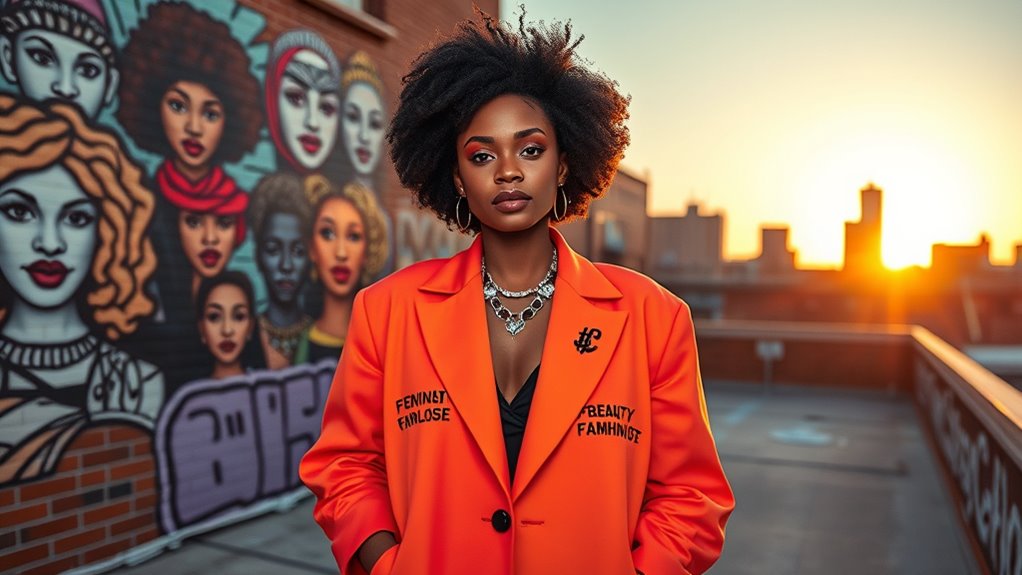
You can challenge traditional beauty standards by choosing fashion that reflects your authentic self. Contemporary feminist fashion encourages you to express your identity freely and boldly. This movement transforms clothing into a statement of empowerment and individuality. Developing a strong sense of cultural intelligence can help you understand and navigate diverse cultural expressions of beauty and identity within feminist fashion. Recognizing the importance of inclusive sizing in fashion helps promote body positivity and representation for all women. Embracing diverse beauty standards allows for a more comprehensive understanding of empowerment through clothing.
Challenging Traditional Standards
Traditional beauty standards have long dictated how women should look and present themselves, but contemporary feminist fashion actively challenges these norms. You’re encouraged to question gender norms that confine women to specific roles or appearances, promoting a more inclusive understanding of beauty. By embracing body positivity, feminist fashion pushes back against unrealistic ideals that often lead to shame or self-doubt. Instead of conforming, you’re invited to celebrate diverse sizes, shapes, and styles, asserting that worth isn’t defined by societal standards. This movement empowers you to reject narrow definitions of femininity, fostering confidence through authentic expression. Ultimately, challenging traditional standards allows you to reclaim your identity and redefine what beauty means on your own terms.
Expressing Personal Identity
How do you define your own beauty and identity in a world full of conflicting standards? Today, fashion offers you a way to express your authentic self. You can challenge norms by emphasizing your gender expression and cultural identity. To do this:
- Embrace clothing that reflects who you truly are, regardless of societal expectations.
- Mix traditional and modern styles to celebrate your cultural roots.
- Use accessories and colors to highlight your unique personality and beliefs.
- Incorporate mindful decluttering strategies to reinforce your confidence and authenticity through fashion choices. This can help you curate a wardrobe that truly resonates with your identity and reduces unnecessary clutter.
Contemporary feminist fashion encourages you to break free from narrow beauty standards and showcase your individuality. By consciously choosing what to wear, you reclaim power over how others perceive you and affirm your personal identity. Ultimately, your fashion choices become a statement of empowerment and self-acceptance.
Fashion as a Tool for Intersectional Feminism and Social Change
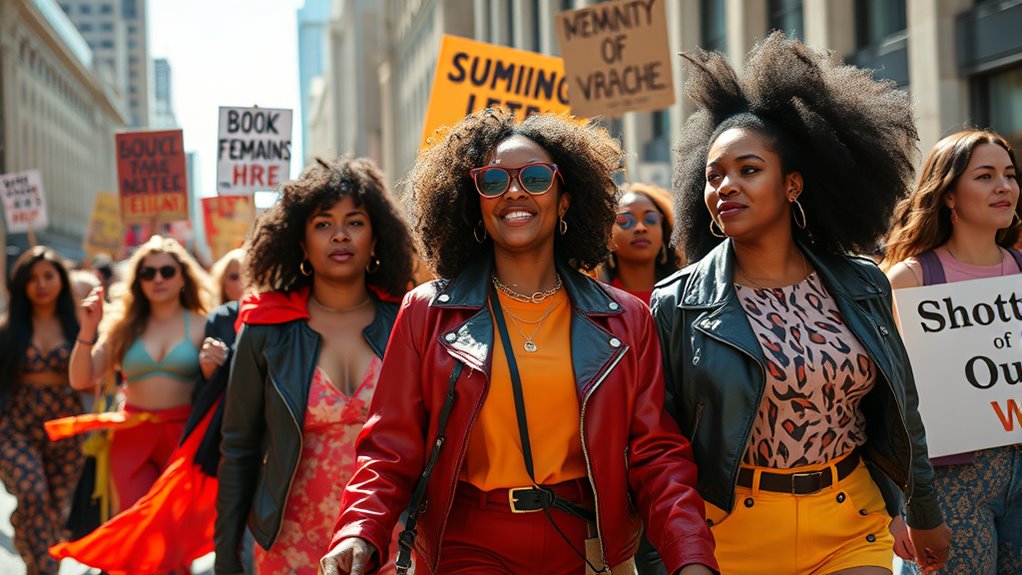
Have you ever considered how fashion can serve as a powerful tool for advancing intersectional feminism and social change? By choosing sustainable fashion, you support environmental justice and ethical production, aligning with feminist goals of equity. Fashion also highlights issues like cultural appropriation, encouraging awareness and respectful representation. When you wear or promote diverse styles, you challenge stereotypes and amplify marginalized voices. Here’s a visual to inspire your activism:
| Action | Impact | Consideration |
|---|---|---|
| Support sustainable brands | Reduce environmental harm, promote equity | Avoid greenwashing |
| Celebrate diverse styles | Foster inclusion, challenge stereotypes | Respect cultural origins |
| Call out cultural appropriation | Raise awareness, promote cultural respect | Educate yourself and others |
Through thoughtful choices, your fashion decisions can drive social change and foster intersectional feminism. Additionally, understanding the importance of diverse representation in fashion can help challenge existing power structures and promote inclusivity across different communities. Recognizing the role of inclusive design practices can further promote equity and accessibility in fashion spaces. Incorporating fashion activism into your wardrobe choices empowers marginalized groups and amplifies their voices in broader societal conversations.
Frequently Asked Questions
How Did Fashion Choices Influence Women’s Societal Acceptance Historically?
You can see that fashion choices have historically shaped women’s societal acceptance by challenging strict dress codes and breaking free from fashion stereotypes. When women defied traditional dress codes, they gained more visibility and autonomy, influencing public perceptions. By choosing clothing that expressed individuality, women slowly transformed societal expectations, making way for greater acceptance and empowerment. Your fashion choices, thus, played a vital role in redefining women’s roles and breaking down barriers.
What Role Did Fashion Play in Challenging Gender Stereotypes?
Imagine fashion as a bold river carving through rigid gender roles, reshaping societal expectations. When you embrace fashion activism, you challenge stereotypes, turning clothing into a symbol of resistance. By choosing styles that defy traditional gender norms, you help break down barriers, making space for equality. Your wardrobe becomes a powerful tool, empowering you and others to redefine what it means to be masculine or feminine.
How Has Fashion Contributed to Lgbtq+ Feminist Movements?
You see, fashion plays a essential role in LGBTQ+ feminist movements by allowing you to express your gender identity and challenge societal norms. Through embracing queer aesthetics, you can showcase your authentic self and question traditional gender roles. Clothing becomes a tool for gender expression, empowering you and others to resist stereotypes, foster inclusivity, and celebrate diverse identities within the movement.
Can Clothing Be a Form of Silent Protest Beyond Visible Symbols?
Think of clothing as a canvas where silence speaks volumes—your silent protest can be more powerful than words. Beyond visible symbols, fashion activism lets you challenge norms and express your beliefs subtly yet boldly. By choosing specific styles or avoiding mainstream trends, you send a message of resistance and solidarity, making your attire a tool for social change. Clothing becomes your voice, turning everyday wear into a form of silent protest.
How Do Cultural Differences Impact Feminist Fashion Expressions Globally?
You’ll notice that cultural differences shape feminist fashion expressions worldwide. Your cultural identity influences how you interpret and use clothing to challenge norms, revealing diverse perspectives. In an era of fashion globalization, you may blend global trends with local customs, creating unique styles that reflect your beliefs. This dynamic interaction allows you to express your feminism authentically, respecting cultural nuances while advocating for women’s rights across different societies.
Conclusion
Throughout history, fashion has been a powerful tool for women’s liberation. Did you know that in 2020, over 60% of women felt more confident expressing themselves through clothing? By embracing style as a form of activism, you can challenge norms, reclaim identity, and inspire change. Remember, what you wear isn’t just about looks—it’s a statement of empowerment and resistance that continues to shape feminism today.
